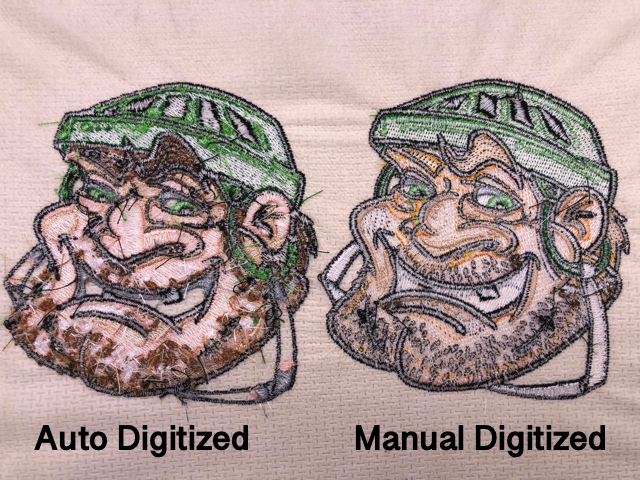Inexpensive Digitizing for Embroidery: Precision and Detail
Explore Different Kinds Of Embroidery Digitizing Strategies
Needlework digitizing has progressed considerably over the years, providing a myriad of methods to bring styles to life in the electronic world. The world prolongs to extra innovative strategies like photorealistic needlework digitizing and the remarkable world of 3D embroidery digitizing.
Standard Hand Embroidery Digitizing
Conventional hand embroidery digitizing involves the process of converting intricate hand-stitched designs right into electronic layouts for equipment needlework. This strategy calls for experienced artisans to thoroughly examine the handmade style and afterwards use specialized software program to recreate it in a digital style. Each stitch, color, and information has to be carefully translated to make certain that the significance of the initial hand embroidery is preserved in the electronic variation.
One of the key obstacles of conventional hand embroidery digitizing is catching the ins and outs and subtleties of the handmade layout. Digitizing for Embroidery. Craftsmens should possess a deep understanding of different needlework techniques, such as satin stitch, chain stitch, and French knots, to precisely replicate these techniques in the electronic realm. Furthermore, they need to have an eager eye for information to make sure that the digital layout preserves the same degree of artistry and workmanship as the original hand-stitched item
Punching Method
To seamlessly change from conventional hand embroidery digitizing to the boxing method, craftsmens should now concentrate on transforming the elaborate electronic layouts right into instructions that embroidery devices can interpret. The boxing technique entails using specialized software program to produce electronic files that have commands for the needlework maker to comply with. This procedure needs a deep understanding of not simply the style itself yet likewise the capacities and restrictions of the embroidery machine.

Auto-Digitizing Software Program Programs
Needlework digitizing has actually been reinvented by the advent of auto-digitizing software application, providing craftsmens with advanced tools to convert digital designs into needlework device instructions efficiently. Auto-digitizing software programs use algorithms to analyze electronic pictures or vector data and produce needlework styles immediately. These programs enable for fast and exact conversion of intricate designs into stitch patterns, saving effort and time for embroiderers.
One of the vital benefits of auto-digitizing software program is its user-friendly interface, making it available to both beginners and skilled digitizers. These programs usually consist of features such as stitch editing and enhancing devices, string color matching, and the capability to preview the final embroidered design. In addition, auto-digitizing software application can deal with complex layouts with numerous colors and elaborate details, producing premium embroidery documents suitable for various clothing and fabric tasks.
While auto-digitizing software supplies convenience and effectiveness, it is crucial for individuals to comprehend the limitations of automated digitizing. Fine-tuning and hands-on modifications may still be needed to attain the desired needlework top quality, specifically when managing intricate or unique designs. By leveraging the capabilities of auto-digitizing software together with hand-operated digitizing methods, craftsmens can enhance their needlework digitizing procedure and create magnificent embroidered pieces.
Photorealistic Needlework Digitizing
Utilizing sophisticated electronic imaging techniques, attaining photorealistic results in needlework digitizing has come to be a popular ability among contemporary craftsmens. This method entails converting high-resolution images into detailed stitch patterns that carefully mimic the initial style, resulting in needlework pieces that show realistic information and deepness.
To achieve photorealistic needlework digitizing, artisans need to have a keen eye for detail and a detailed understanding over at this website of exactly how various stitch types and densities can influence the last outcome. By meticulously drawing up each color and color in the image, embroiderers can create a digital documents that overviews the embroidery device to reproduce the subtleties of the initial picture properly.
Photorealistic needlework digitizing is especially popular in producing custom designs for apparel, home design, and art pieces where recording the essence of a photo or art work is critical. This method permits artisans to change memories, landscapes, portraits, and complex artwork right into sensational embroidered masterpieces that display a mix of traditional craftsmanship and sophisticated technology.
3D Needlework Digitizing
With the advancement of digital imaging techniques in accomplishing photorealistic outcomes in needlework digitizing, the exploration of 'D Needlework Digitizing' provides a new dimension to the ins and outs of style replication. 'D Embroidery Digitizing' refers to the three-dimensional digitizing method that adds deepness and texture to needlework styles, developing a more realistic and aesthetically appealing last product. This technique makes use of software application that mimics the effect of light and shadow on the needlework style, improving its total visual effect.
Among the crucial benefits of 'D Needlework Digitizing' is its capability to make layouts look even more lifelike and vibrant. By adding deepness to the embroidery layout, the last product shows up much more reasonable and captivating (Digitizing for Embroidery). In addition, this method permits more imaginative flexibility in design implementation, allowing embroiderers to explore different appearances and impacts that were from this source formerly challenging to achieve
Conclusion
